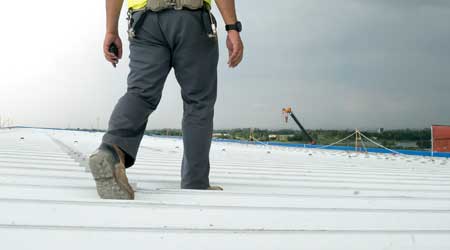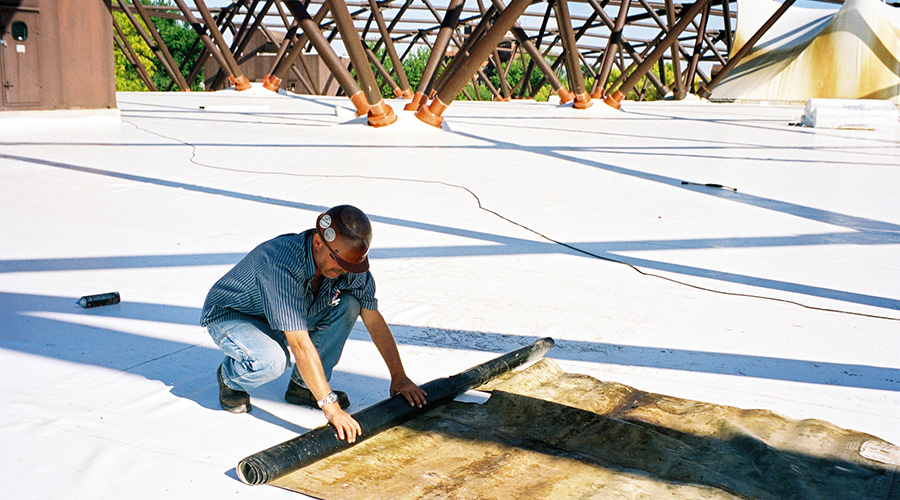3 Roofing Trouble Spots and How to Prevent Them
By focusing on flashings, penetrations, and foot traffic, managers can extend roof performance life.
Roofing systems on institutional and commercial facilities are typically an afterthought for building occupants – until the roof leaks, that is. Roof leaks are a nuisance at best for occupants, but they can often result in property damage and costly repairs. In fact, water intrusion accounts for more than 70 percent of construction litigation.
For maintenance and engineering managers, roof systems are one of the more challenging components to maintain on buildings. In order to efficiently use department resources, managers can focus their maintenance efforts on three of the most common roofing trouble spots: flashing, roof penetrations and foot traffic. The best way to combat these issues is by implementing regular inspection, comprehensive repairs and persistent prevention.
1. Flashing points
Flashings are only a small percentage of the total area of a roof, but a technician often can trace problems and leaks back to a flashing rather than the field membrane. Anywhere a membrane terminates is an opportunity for water infiltration and, therefore, a weak spot in the system, especially if installers did not detail it properly. Wind uplift also is up to 1.5 times stronger at the perimeters of a roof and 2.5 times stronger at its corners compared with its field, making perimeter flashings and copings more vulnerable.
Because of their importance, flashing materials should meet or exceed the life expectancy of the roof. Flashings often connect different moving components, so they should be able to accept thermal and load-induced movement, especially if they are located above an expansion joint.
Material choice is important early in the process. Prefabricated products and pre-applied tape products in lieu of adhesive seams in EPDM membranes, for example, can eliminate multiple installation steps and human error during installation, says one major roofing manufacturer.
Ponding water on flashing seams increases the chance of failure, so technicians should take steps to avoid them where possible. They can install cant strips at any 90-degree transitions on the roof. This 45-degree gradual transition, rather than the abrupt 90-degree transition, reduces the risk of failure in these areas and sheds water away from the flashings.
To further reduce ponding at flashing seams, technicians should build crickets or water diverters around mechanical curbs to assist drainage. Vertical flashings typically should extend at least 8 inches above the roof. Installing a PVC condensate line to carry water from rooftop HVAC equipment to the nearest drain is a simple and inexpensive solution to reduce ponding. Technicians also should keep roof drains clear and functional.
During routine inspections, technicians should note open seams, punctures, discolorations and sagging membranes on vertical curbs. Membrane bridging commonly occurs when the membrane becomes unadhered from the vertical rising wall, parapet or curb. The bridging strains the material, which can lead to rips and tears. Technicians should preventively patch the area until the next roof replacement.
On metal components such as counterflashings, drip edges, parapet caps and gravel stops, technicians can check for: loose, missing or bent fasteners; bent, corroded or missing sheet metal; and failed, crazed or open sealant joints. Most problems associated with flashings should be obvious to even those unfamiliar with roof systems. Technicians can check the coping for the ability to withstand wind uplift by pulling out the lower edge, according to FM Global. If it feels loose, it can be re-secured fairly inexpensively with appropriate weather-resistant fasteners with washers.
Flashings also should be inspected annually or after big weather events. If sections of the roof are opened, technicians should not ignore other discovered issues, such as rotted wood nailers, corroded fasteners and deteriorated insulation. If repairs are required, technicians must be sure to detail them properly and use materials compatible with the roof type. Many studies show that following the manufacturer’s recommended inspection and repair schedule results in longer roof life and overall lower roof costs. For the lowest costs, it is especially important to keep the insulation dry and in good condition, according to FM Global.
2. Roof penetrations
Flashing problems are not limited to roof perimeters. They also can occur at roof penetrations. Many such penetrations are prominent, such as around piping, skylights and mechanical equipment. Technicians also must be sure to note and inspect flashings around smaller penetrations, such as those around conduits, stair supports and other less obvious locations for water intrusion. Prefabricated flashing, such as pipe seals, sealant pockets and corner flashings, are common solutions for such problems and come ready to install, says one major roofing manufacturer.
While it is easy to blame the roof system for problems around penetrations, it might not be the failure of the roof causing a leak. Degraded or bent mechanical curb caps can leave openings for water infiltration. Deteriorated masonry, failed through-wall flashing and sealants on a rising wall above a roof system offer other opportunities for water infiltration. Heavy rains might be able to get over shallow door thresholds and enter penthouse spaces.
Technicians need to check openings in electrical junction boxes. Even the smallest and seemingly insignificant openings allow an opportunity for water to find its way under the roofing system, despite the roof flashings doing their jobs. When new penetrations are installed in a roof, technicians need to make sure they are detailed properly and accepted by the roofing manufacturer if the system is still under warranty.
3. Foot traffic
Roof problems related to foot traffic is primarily related to maintenance and repair personnel who need to access rooftop equipment. They might use tools and equipment that could inadvertently pierce, cut, scrape or otherwise damage the roof membrane.
In-house staff should report any damage to the membrane during routine work and after maintenance projects that involve outside contractors. In general, managers should limit roof access to authorized personnel and be aware that the membrane manufacturer might have restrictions related to access during cold weather.
The best way to limit the impact of rooftop traffic is to install pavers or walk pads over the roof surface. To increase the chance that authorized visitors use pathways, they should be the most direct and logical path to each piece of rooftop equipment.
For work near unprotected edges that is infrequent and temporary — replacing filters or cleaning roof drains, for example — personnel within 6 feet of the roof edge need to wear a personal fall arrest system (PFAS) anchored per an approved safety plan or protected by a guardrail system, according to OSHA 29 CFR 1910 Subpart D. Work that is 6-15 feet from the roof edge requires the use of either a PFAS or a designated area with warning lines. With these regulations in mind, pathways should not be installed within 15 feet of the roof edge to promote a safe traveling distance from the unprotected edge. In locations where installation beyond 15 feet is not possible, guardrails should be installed.
While pavers protect the roof membrane from foot traffic, they also can be responsible for hiding drainage issues and covering up deterioration, vegetative growth and build-up debris. Composite insulated pavers combine insulation properties with foot-traffic protection. If water is not draining properly under the pavers, growth and deterioration will occur, reducing the effectiveness of the insulation.
Managers should perform wind uplift calculations before approving installation of concrete pavers to determine the required parapet height according to ANSI/SPRI RP-4. At some building heights and locations, ballast might not be permitted. In these cases, managers should specify adhered walk pads in lieu of concrete pavers. Managers also should assess the roof’s structural capacity to determine if it can adequately support the ballast weight before installation.
Roofing systems degrade over time and require repairs as they near the end of their performance lives. But when properly maintained, they can exceed their expectations. It’s a good practice for technicians to walk a roof a handful of times per year and even implement an annual maintenance program with a qualified roofing professional, says one major roofing manufacturer, adding that a roof with a proactive maintenance program will last longer than a roof with a reactive maintenance program.
If a roof is nearing the end of its performance life, an assessment by a roof consultant is effective in estimating how long until a roof replacement might be needed and the repairs are recommended until that time. Monitoring and documenting the frequency of leaks and the cost of repairs also can help managers determine the timing of replacement.
Erin Falvey is a project engineer at Facility Engineering Associates. Falvey has a degree in civil engineering from the University of Virginia and works on delivering engineering solutions to clients to maximize the life of physical assets through repair and restoration projects in roofing, building exteriors, parking garages and fall protection.
Related Topics:












